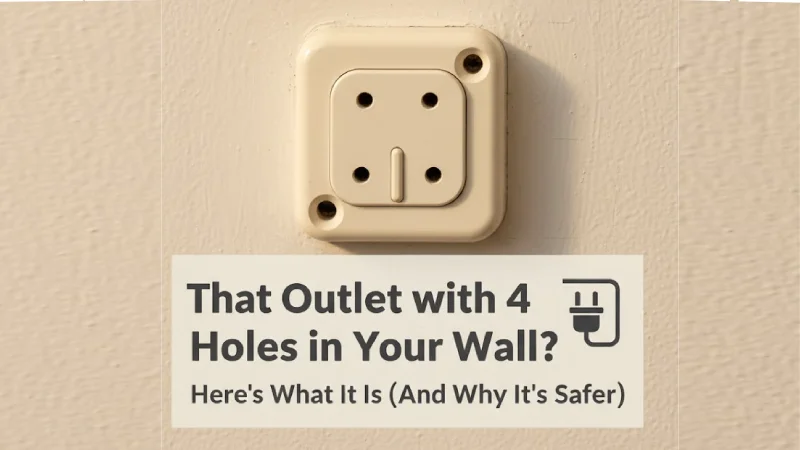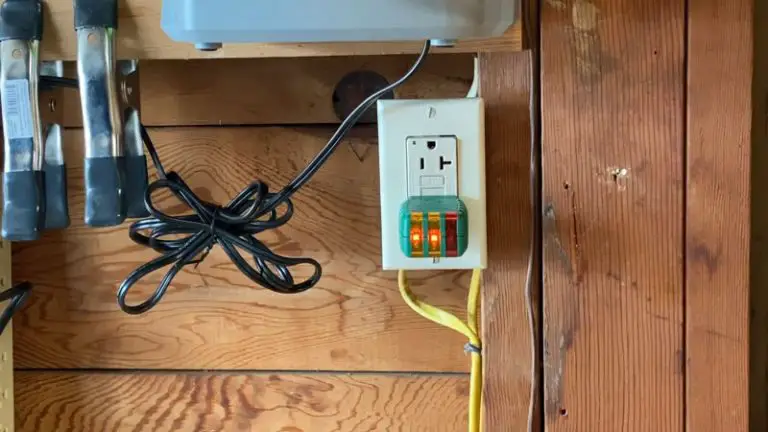That Outlet with 4 Holes in Your Wall? Here’s What It Is (And Why It’s Safer)
You’ve seen it in your laundry room, kitchen, or garage: a large, unusual outlet with four distinct holes. It doesn’t look like any other plug in your home, which naturally leads to questions. What is this powerful-looking outlet for, and why does it have four slots instead of the usual two or three?
The simple answer is that this is a 240-volt receptacle, designed to power your most energy-hungry appliances. The four holes are a critical safety feature mandated by modern electrical codes, offering significantly more protection than older designs. Understanding its purpose is key to ensuring your home’s large appliances run safely and efficiently.
You'll Learn About
What Exactly Is an Outlet with 4 Holes?
That 4-hole outlet is a dedicated circuit for major appliances that require 240 volts to operate, which is double the voltage of a standard household outlet. Standard outlets provide 120 volts and are sufficient for lamps, TVs, and phone chargers. However, appliances with large motors or powerful heating elements, like electric dryers and kitchen ranges, need much more power to function correctly.
These outlets are officially known by their NEMA designation. NEMA stands for the National Electrical Manufacturers Association. You will most commonly encounter two types in a residential setting:
- NEMA 14-30: This is a 30-amp receptacle and is the modern standard for electric clothes dryers.
- NEMA 14-50: This is a 50-amp receptacle used for larger appliances like electric ranges, ovens, and is also a popular choice for home electric vehicle (EV) charging stations.
The move to a 4-prong design became standard in the National Electrical Code (NEC) in 1996 to enhance safety. Homes built before this time often have older, 3-prong 240-volt outlets.
The Mystery of the 4 Holes Explained: A Detailed Breakdown
Each of the four holes in the outlet serves a very specific and crucial function. Unlike a standard 120-volt outlet that has one hot, one neutral, and one ground wire, a 240-volt outlet has a more complex job to do.
Here’s what each of the four wires connected to those holes does:
- Two “Hot” Wires: There are two hot wires, typically one black and one red. Each carries 120 volts of electricity. The appliance combines these two lines to achieve the full 240 volts needed for heavy-duty tasks like heating the coils in a dryer or oven.
- One “Neutral” Wire: The white wire is the neutral conductor. Its primary job is to provide a return path for the current and to power smaller 120-volt components within the appliance, such as timers, electronic controls, and interior lights.
- One “Ground” Wire: The green or bare copper wire is the dedicated equipment ground. This is purely a safety feature. In the event of an electrical fault or short circuit, the ground wire provides a safe path for the electricity to travel back to the breaker panel, tripping the breaker and cutting off the power.
3-Prong vs. 4-Prong Outlets: The Critical Safety Difference
The biggest reason for the switch from 3-prong to 4-prong outlets is safety. In older 3-prong setups, there was no separate ground wire. Instead, the neutral wire was required to do double duty, serving as both the neutral conductor and the ground path.
This created a significant risk. If the combined neutral/ground wire became loose or failed, the electrical current could energize the metal frame of the appliance. This turns the dryer or stove into a serious shock hazard, as anyone touching it could become the path to the ground.
The 4-prong outlet solves this problem by completely separating the neutral and ground paths. The dedicated ground wire ensures that even if the neutral connection fails, the appliance’s metal casing remains safely grounded, drastically reducing the risk of electric shock. Since 1996, the NEC has required 4-prong outlets for all new dryer and range installations to mitigate this danger.

Common Problems & Questions About 4-Hole Outlets
The transition from 3-prong to 4-prong systems often creates confusion for homeowners. One of the most common problems is a mismatch between a new appliance and an old outlet.
For instance, you might buy a brand-new dryer that comes with a 4-prong cord, only to find that your laundry room has an older 3-prong outlet. This is a frequent issue in homes built before the mid-1990s. In this situation, you have two choices: change the dryer’s cord to a 3-prong version or, the much safer and recommended option, upgrade the outlet to a 4-prong receptacle.
Another common question is whether this type of outlet can be used for charging an electric vehicle. The answer is yes; a NEMA 14-50 outlet is one of the most popular and cost-effective solutions for Level 2 home EV charging, which is significantly faster than a standard 120-volt wall outlet.
| Feature | 3-Prong Outlet (NEMA 10-30/10-50) | 4-Prong Outlet (NEMA 14-30/14-50) |
|---|---|---|
| Wires | Two Hot, One Combined Neutral/Ground | Two Hot, One Neutral, One Separate Ground |
| Voltage | 240 Volts | 120/240 Volts (Split) |
| Safety | Outdated; poses a shock risk if neutral fails | Modern standard; significantly safer with dedicated ground |
| NEC Standard | Allowed before 1996 | Required for new installations since 1996 |
| Common Uses | Found in older homes for dryers and ranges | Modern dryers, ranges, and EV chargers |
The Solution: How to Safely Upgrade to a 4-Hole Outlet
Warning: Working with 240-volt circuits is extremely dangerous and can be lethal if handled improperly. This guide is for informational purposes only. It is always recommended to hire a licensed electrician to perform this work to ensure it is done safely and up to code.
If your home has a 3-prong outlet but the wiring inside the wall includes a fourth ground wire (which is sometimes the case in homes built during the transition period), upgrading the receptacle is a relatively straightforward job for a professional. The process generally involves these steps:
- Turn Off the Power: The absolute first step is to shut off the corresponding double-pole breaker in your electrical panel. Use a voltage tester at the outlet to confirm with 100% certainty that the power is off before proceeding.
- Remove the Old Outlet: The cover plate and the old 3-prong receptacle are unscrewed and gently pulled from the electrical box.
- Identify the Wires: The electrician will identify the two hot wires, the neutral wire, and the ground wire. If no ground wire is present in the cable, the project becomes more complex, as a new 4-conductor cable must be run from the breaker panel.
- Connect the New 4-Prong Outlet: The new NEMA 14-30 or 14-50 receptacle is wired according to the manufacturer’s instructions. The black and red hot wires connect to the brass terminals, the white neutral wire connects to the silver terminal, and the green or bare ground wire connects to the green ground screw.
- Secure and Test: The new outlet is secured in the box, the cover plate is attached, and the power is restored at the breaker. The electrician will then test the outlet to ensure it is wired correctly and providing the proper voltage.
When You Absolutely Must Call a Professional Electrician
While some home projects are suitable for DIY enthusiasts, upgrading a 240-volt outlet is generally not one of them. The risks of fire and severe electrical shock are too high. You should always call a professional electrician if:
- Your existing electrical cable in the wall only has three wires.
- You are not 100% confident in your ability to work safely with high-voltage electricity.
- The wiring in your home is old, especially if it is aluminum wiring.
- The circuit breaker in your panel does not have the correct amperage for the appliance (e.g., a 30-amp breaker for a dryer).
- You need to install a completely new 240-volt circuit where one did not previously exist.
Electrical work is not the place to cut corners. A licensed professional will ensure the job is done correctly, safely, and in compliance with all local electrical codes.
Beyond the Laundry Room: Other Uses for 4-Hole Outlets
While most commonly associated with dryers and stoves, these powerful outlets are versatile. A NEMA 14-50 outlet, in particular, is useful in workshops or garages for powering heavy-duty equipment like large air compressors or welders. As mentioned, their most rapidly growing new use is for home EV charging.
A Note on EV Charging
Using a NEMA 14-50 outlet with a compatible portable charger can provide Level 2 charging speeds, which can replenish an EV battery overnight. This is a huge step up from the slow trickle of a standard Level 1 charger that plugs into a 120-volt outlet. If you plan to install an outlet for an EV, it’s crucial that it’s on a dedicated circuit and that a high-quality, industrial-grade receptacle is used to handle the sustained load of charging a vehicle for hours at a time.
Maintaining Your High-Power Outlets
Once your outlet is installed, maintenance is minimal but important. Periodically check that the appliance cord fits snugly into the receptacle. A loose connection can generate heat and become a fire hazard. Also, ensure the cord is not frayed or damaged. Good cord management is important for safety; for instance, learning how to secure an extension cord to an outside wall properly can prevent trips and damage. This mindset of regular home upkeep is crucial. Just as you’d want to know what happens if you forgot to winterize your lawn mower, proactive checks on your home’s electrical systems can prevent much larger problems down the road.
When planning for major home systems, it’s common to evaluate multiple upgrades at once. While ensuring your high-power appliances have the correct electrical supply, you might also consider other large investments. Many homeowners find themselves researching topics like the Maytag water treatment system price as they budget for comprehensive home improvements.
Conclusion: Mastering the Power of the 4-Hole Outlet
That mysterious outlet with 4 holes is no longer a puzzle. It is a modern, high-power 240-volt receptacle designed with your safety as the top priority. Its four-wire system provides a dedicated ground, protecting you and your family from the electrical hazards present in older 3-prong systems.
Whether you’re installing a new dryer, upgrading your kitchen range, or joining the electric vehicle revolution, understanding the function of a 4-hole outlet is essential. Always prioritize safety, and when it comes to installation or upgrades, trust the expertise of a licensed electrician to get the job done right.

